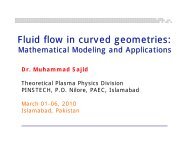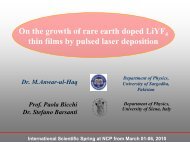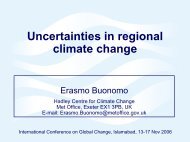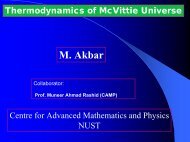Dynamics of wind erosion and numerical prediction ofB dust storm
Dynamics of wind erosion and numerical prediction ofB dust storm
Dynamics of wind erosion and numerical prediction ofB dust storm
You also want an ePaper? Increase the reach of your titles
YUMPU automatically turns print PDFs into web optimized ePapers that Google loves.
<strong>Dynamics</strong> <strong>of</strong> Wind Erosion<br />
<strong>and</strong> Numerical Predictions <strong>of</strong><br />
Dust Storm<br />
Hu Fei <strong>and</strong> Qing-Cun Zeng<br />
Institute <strong>of</strong> Atmospheric Physics, Chinese Academy <strong>of</strong> Sciences China
Outline<br />
1. General characteristic pictures <strong>of</strong> <strong>dust</strong> <strong>storm</strong><br />
2. The mechanism <strong>of</strong> soil <strong>erosion</strong> <strong>and</strong> <strong>dust</strong> emission<br />
3. Impulsive emission <strong>of</strong> <strong>dust</strong> by the gust <strong>wind</strong> <strong>and</strong><br />
Parameterization <strong>of</strong> gust effect.<br />
4. Numerical <strong>prediction</strong> <strong>of</strong> <strong>dust</strong> <strong>storm</strong><br />
5. Climate-environmental conditions favorable (or<br />
suppressive) for the frequency <strong>and</strong> intensity <strong>of</strong> <strong>dust</strong><br />
<strong>storm</strong>s <strong>and</strong> their <strong>prediction</strong> by DCP/IAP
Physically, <strong>dust</strong> <strong>storm</strong> is a natural phenomenon<br />
which is known to have already existed long before<br />
the appearance <strong>of</strong> human civilization.<br />
There are vast regions <strong>of</strong> arid <strong>and</strong> semi -arid<br />
l<strong>and</strong>forms around the Tropics on the Earth's<br />
surface, which are formed as a result <strong>of</strong> general<br />
circulation, topography <strong>and</strong> other factors. The<br />
typical l<strong>and</strong>forms which emerge in these regions are<br />
large areas <strong>of</strong> desert, e.g. Sahara, Central <strong>and</strong><br />
Southwest Asia, West Australia, <strong>and</strong> South-west<br />
part <strong>of</strong> North America.
Satellite Image <strong>of</strong> Dust Storm in Middle East <strong>and</strong> South Asia
Satellite Image <strong>of</strong> Dust Storm in Sahara Desert
Satellite Image <strong>of</strong> Dust Storm in United States
Satellite Image <strong>of</strong> Dust Storm in East Asia
Luoyang, China<br />
Lanzhou, China
Beijing,<br />
China
Fukuoka, Japan<br />
Seoul, Korea
Because <strong>dust</strong> <strong>storm</strong>s cross international boundaries, they<br />
become a problem shared by many countries. For this reason,<br />
<strong>and</strong> owing to the wide expanses they cover, it is still hard to<br />
study <strong>and</strong> underst<strong>and</strong> their causes <strong>and</strong> where they originate.<br />
In recent years, much more attention has been paid on the<br />
impacts <strong>of</strong> human activities on Earth's environment,<br />
including the <strong>dust</strong> <strong>storm</strong> production. Indeed, with the rapid<br />
increase <strong>of</strong> world population <strong>and</strong> the rapid development <strong>of</strong><br />
social-economy activity since the in<strong>dust</strong>rial era, human<br />
behaviours are showing an increasing ability to affect the<br />
global climate <strong>and</strong> environment.
Example <strong>of</strong> Grassl<strong>and</strong> Desertification<br />
(Inn MongoliaChina)
Desert Area in China<br />
S<strong>and</strong> De<br />
S<strong>and</strong> Desert<br />
Gobi<br />
Desert<br />
Desert area<br />
Gobi desert<br />
Desertification area<br />
Desertification treading
Distribution <strong>of</strong> the total number <strong>of</strong> <strong>dust</strong> strom<br />
days over China averaged form 1956 to 2000<br />
>
681 meteorological observation stations <strong>of</strong> China
Dust <strong>storm</strong> observation stations <strong>of</strong> China
More then 100 Air Quality Observation Stations (cities)
Observation<br />
Tower in the<br />
desert
Observation tower in Beijing city
Beijing 325m meteorological tower
Eddy-correlation method<br />
τ<br />
H<br />
E<br />
= ρu 2<br />
*<br />
= ρC w′ θ′<br />
p<br />
= ρw′ q′
Example Case: March 20, 2002
March 20, 2002<br />
Cold Front, High Pressure, Strong <strong>wind</strong>
March 20, 2002
Mar.18 17h ~ Mar.19 05h
Mar.19 08h ~ Mar.19 17h
Mar.19 20h ~ Mar.20 05h
Mar.20 08h ~ Mar.20 17h
Mar.20 20h ~ Mar.21 05h
Mar.21 08
24h averaged PM10 concentrition distribution (μg/m 3 )<br />
u<br />
March 20,2002
Air Quality Index API distribution over China (March 20, 2002)<br />
API=5
Number concentration distribution near surface<br />
during the <strong>dust</strong> <strong>storm</strong> period Mar. 19 ~ Mar. 22 ,2002
Dust particle concentration distribution near surface<br />
during the <strong>dust</strong> <strong>storm</strong> period Mar. 19 ~ Mar. 21 ,2002
The Dust Storm Passing Beijing (March 20, 2002)<br />
<br />
Temperature( °C)<br />
Relative humidity% Wind (m/s<br />
TSP<br />
TSPconc.mg/m 3 <br />
10<br />
9<br />
8<br />
7<br />
6<br />
5<br />
4<br />
3<br />
2<br />
1<br />
0<br />
BST<br />
18<br />
16<br />
14<br />
12<br />
10<br />
4<br />
BST 0 2 4 6 8 10 12 14 16 18 20 22 0 2 4 6 8 10 12 14 16 18 20 22<br />
70<br />
60<br />
50<br />
40<br />
30<br />
20<br />
10<br />
0<br />
BST<br />
14<br />
12<br />
10<br />
8<br />
6<br />
8<br />
6<br />
4<br />
2<br />
0<br />
BST<br />
0 2 4 6 8 10 12 14 16 18 20 22 0 2 4 6 8 10 12 14 16 18 20 22<br />
b)<br />
a)<br />
c)<br />
Δ Τ=T 20 -T 19<br />
0 2 4 6 8 10 12 14 16 18 20 22 0 2 4 6 8 10 12 14 16 18 20 22<br />
d)<br />
0 2 4 6 8 10 12 14 16 18 20 22 0 2 4 6 8 10 12 14 16 18 20 22<br />
March 19 March 20<br />
Τ<br />
3<br />
2<br />
1<br />
0<br />
-1<br />
-2<br />
-3<br />
-4<br />
-5<br />
-6<br />
24<br />
24 hour temperature difference(°C)<br />
(a)Wind, (b)T, (c)RH, (d)Concentration <strong>of</strong> Dust (TSP)
The Passage <strong>of</strong> Dust Storm<br />
The <strong>wind</strong> speed <strong>and</strong> temperature (by <strong>wind</strong> wane <strong>and</strong> anemometer<br />
<strong>and</strong> thermometer on Beijing 325m Meteorological Tower).
Transfer<br />
Dust rising<br />
Deposition<br />
Turbulence<br />
Dust moving<br />
Dust flux<br />
S<strong>and</strong> Source Area<br />
The sketch map <strong>of</strong> <strong>dust</strong> <strong>storm</strong>
The Mechanism <strong>of</strong> Dust Emission (Laboratory Modeling)
The Natural Picture <strong>of</strong> Dust Emission (Imagination)<br />
u *<br />
>u *t<br />
(threshold friction velocity<br />
for <strong>dust</strong> emission)
What is it in the reality<br />
• There is large scale/mesoscale systematic<br />
descending motion in the free atmosphere <strong>and</strong><br />
even in the atmospheric boundary layer(ABL)<br />
behind the cold front.<br />
• Descending motion suppresses the <strong>dust</strong><br />
particles to penetrate into the troposphere, <strong>and</strong><br />
those particles can only be accumulated in the<br />
very low levels in the ABL.<br />
• There must be another effective mechanism<br />
for the penetration <strong>of</strong> <strong>dust</strong> particles into the<br />
atmosphere.
• Wind (as well as u * ) is non-steady. The s<strong>and</strong><strong>dust</strong><br />
particles creeping on the l<strong>and</strong> surface have<br />
more chances to collide with each other, so the<br />
probability <strong>of</strong> saltation is enlarged. Therefore,<br />
we have to modify the (laboratorial determined)<br />
*<br />
u *t , or apply an apparent fraction velocity.<br />
u *
Gust Wind <strong>and</strong> the 3-D3<br />
Coherent Structure <strong>of</strong> Wave Train<br />
• Detection <strong>of</strong> the wave train<br />
• The coherent structure <strong>and</strong> the vertical propagation<br />
<strong>of</strong> wave train<br />
• The efficiency <strong>of</strong> coherent disturbances in the<br />
vertical flux <strong>of</strong> momentum.<br />
• Friction (turbulent) Velocity.
Wind speed observation from Beijing 325m tower<br />
47m<br />
Observed by ultrasonic anemometer
Wind speed observation from Beijing 325m tower<br />
47m<br />
Observed by ultrasonic anemometer
Wind speed observation from Beijing 325m tower<br />
120m<br />
Observed by ultrasonic anemometer
Wind speed observation from Beijing 325m tower<br />
280m<br />
Observed by ultrasonic anemometer
20min-average vertical <strong>wind</strong> speed<br />
W(m·s -1 )<br />
0.5<br />
0.4<br />
0.3<br />
0.2<br />
0.1<br />
0.0<br />
-0.1<br />
-0.2<br />
-0.3<br />
-0.4<br />
-0.5<br />
47m<br />
120m<br />
280m<br />
9 10 11 12 13 14 15 16 17 18 19 20 21<br />
Beijing Time (Hour)
Averaged for every 1min (coherent structure)<br />
47m<br />
Wind Velocity (m/s)<br />
Beijing Time (hour)
Averaged for every 1min<br />
120m<br />
Velocity (m/s)<br />
Beijing Time (hour)
Averaged for every 1min<br />
280m<br />
Velocity (m/s)<br />
Beijing Time (hour)
Averaged for every 2min<br />
U Component<br />
Height (m)<br />
Velocity (m/s)<br />
Vertical propagation <strong>of</strong> gust wave train
Relationship between <strong>dust</strong> flux <strong>and</strong> friction velocity<br />
0. 5<br />
0<br />
F<br />
=<br />
1.72 2.93<br />
10 ⋅u*<br />
-0.5<br />
l og( u*)<br />
-1<br />
F<br />
∝<br />
C<br />
⋅<br />
3<br />
u *<br />
-1.5<br />
l og( u* ) = 0. 3415* l og( F) - 0. 5877<br />
-2<br />
R 2 = 0. 5589<br />
-2.5<br />
-3 -2 -1 0 1 2 3<br />
l og( F)<br />
Correlative<br />
coefficient:<br />
Correlative coefficient:<br />
R = 0.748
For <strong>dust</strong> emission, u * should be corrected as u *<br />
*<br />
by taking the effect <strong>of</strong> gust wave train into account.<br />
*<br />
4<br />
4<br />
*<br />
( u ) ≈ u + A(<br />
e )<br />
* g<br />
'<br />
2
280m<br />
(All Fluctuation)<br />
(Gust Wave Train Alone)
3D Coherent Disturbances <strong>and</strong> Impulsive<br />
Penetration <strong>of</strong> Dust
3D Coherent Disturbances <strong>and</strong> Impulsive<br />
Penetration <strong>of</strong> Dust
3D Coherent Disturbances <strong>and</strong> Impulsive<br />
Penetration <strong>of</strong> Dust
During <strong>dust</strong> <strong>storm</strong> event, there is always very strong <strong>wind</strong>,<br />
<strong>and</strong> the prevailing type <strong>of</strong> motion in the ABL is gust <strong>wind</strong>. It<br />
processes 3-D propagating wave train. The gust impulse<br />
'<br />
'<br />
( u<br />
g<br />
> 0) is accompanied by strong descending motion ( w<br />
g<br />
< 0),<br />
'<br />
' '<br />
downward transport <strong>of</strong> momentum ( uw ' < 0, uv ), <strong>and</strong> <strong>dust</strong><br />
g g<br />
< 0<br />
emission (F, Q > 0) from soil surface layer; while the gust<br />
break is accompanied by strong impulse <strong>of</strong> ascending<br />
'<br />
motion ( w ), which makes the <strong>dust</strong> particles accumulated<br />
g<br />
> 0<br />
in the surface <strong>and</strong> lowest levels <strong>of</strong> ABL due to the<br />
suppression <strong>of</strong> systematical meso-scale descending motion)<br />
penetrating into the upper levels <strong>of</strong> ABL <strong>and</strong> further into<br />
the free atmosphere. This is a very effective mechanism <strong>of</strong><br />
downward transport <strong>of</strong> momentum <strong>and</strong> <strong>dust</strong> emission <strong>and</strong><br />
entrainment.
Numerical Prediction <strong>of</strong> Dust Storm Weather<br />
Initialization<br />
Boundary Cond.<br />
Surface<br />
Elevation<br />
Regional NWP<br />
model<br />
+<br />
Dust transport<br />
model<br />
Dust<br />
characteristic<br />
s<br />
GIS<br />
LSM<br />
Dust Emission<br />
Model<br />
User
850hPa (08:00, April 7, 2001) — Height, ⋅⋅⋅⋅ Temperature<br />
LeftObservationRight24 hour <strong>prediction</strong>
11 h 14 h<br />
April 6,2001<br />
April 7,2001<br />
April 8,2001<br />
April 9,2001<br />
Predicted <strong>dust</strong> concentration <strong>and</strong> the observed weather phenomena
Climate Anomalies <strong>and</strong><br />
Environmental Conditions<br />
Favorable (/Suppressive) for the<br />
Frequency <strong>and</strong> Intensity <strong>of</strong> Dust<br />
Storms <strong>and</strong> Their Predictions<br />
(Extraseasonal, by IAP/DCP)
Mar.- Apr. mean anomalies, 2001.<br />
Frequent <strong>and</strong> strong <strong>dust</strong> <strong>storm</strong> events<br />
Upper left: 850hpa <strong>wind</strong> vector <strong>and</strong> <strong>wind</strong> speed.<br />
Upper right: 850hpa <strong>wind</strong> vector <strong>and</strong> surface<br />
temperature.<br />
Bottom: 850hpa <strong>wind</strong> vector <strong>and</strong> surface RH.<br />
Observation<br />
Red: positive anomaly,<br />
Blue: negative anomaly.
Mar.- Apr. mean anomalies, 2001.<br />
(Predicted by DCM/IAP, initiated from Oct.<br />
2000)<br />
Prediction<br />
Upper left: 850hpa <strong>wind</strong> vector <strong>and</strong> <strong>wind</strong> speed<br />
(red: positive anomaly, blue: negative anomaly).<br />
Upper right: Soil wetness <strong>and</strong> probability <strong>of</strong> its<br />
positive anomaly (red: >50%, blue:50%,<br />
blue:
Mar.- Apr. mean anomalies, 2003.<br />
(Seldom <strong>and</strong> weak <strong>dust</strong> <strong>storm</strong> events)<br />
Upper left: 850hpa <strong>wind</strong> vector <strong>and</strong> <strong>wind</strong><br />
speed.<br />
Upper right: 850hpa <strong>wind</strong> vector <strong>and</strong> surface<br />
temperature.<br />
Bottom: 850hpa <strong>wind</strong> vector <strong>and</strong> surface RH.<br />
Observation<br />
Red: positive anomaly,<br />
Blue: negative anomaly.
Mar.- Apr. mean anomalies, 2003.<br />
(Predicted by DCM/IAP, initiated from Oct.<br />
2002)<br />
Prediction<br />
Upper left: 850hpa <strong>wind</strong> vector <strong>and</strong> <strong>wind</strong> speed<br />
(red: positive anomaly, blue: negative anomaly).<br />
Upper right: Soil wetness <strong>and</strong> probability <strong>of</strong> its<br />
positive anomaly (red: >50%, blue:50%,<br />
blue:
Conclusions<br />
‣ Dust <strong>storm</strong> is a very severe disastrous weather<br />
system consisting <strong>of</strong> strong <strong>wind</strong>, soil <strong>erosion</strong>, air<br />
pollution by <strong>dust</strong> particles, <strong>and</strong> very low visibility.<br />
‣ Wind gust <strong>and</strong> its relevant coherent disturbances in<br />
the ABL play a crucial role in the <strong>dust</strong> emission <strong>and</strong><br />
its penetration into the atmosphere.<br />
‣ Dust <strong>storm</strong> weather can be well predicted.<br />
‣ Dynamical <strong>prediction</strong> <strong>of</strong> climate condition favorable<br />
(or suppressive) for the frequent occurrence <strong>of</strong> <strong>dust</strong><br />
<strong>storm</strong>s is encouraging.
Thank You
Satellite Image <strong>of</strong> Dust Storm in East Asia
















